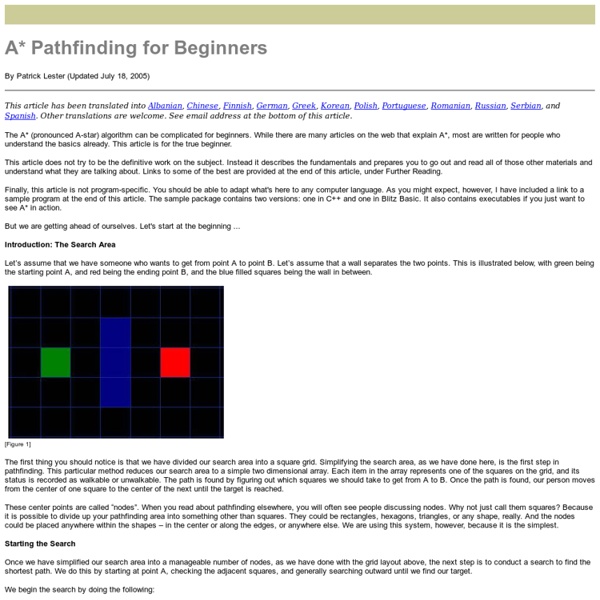Two-Tiered A* Pathfinding
In my main article, A* Pathfinding for Beginners, I described A* in very general terms, and described how to create a single all-purpose pathfinding function. Creating only one pathfinding function, however, can be needlessly limiting. Consider the following RPG situation, and a swordsman who wants to pathfind around a nearby wall: Given this kind of map, you could place nodes in a variety of ways, and use a variety of densities. In this graphic, the white nodes are walkable. As you can see, using this tightly packed node network, we can pathfind not only around the nearby wall but also between the wall and the nearby barrel in the process. Well, that is pretty cool in short-distance situations, but what do we do if we need to pathfind across the entire map? So let's look at an alternative. In this example, the nodes are in the center of the large isometric diamonds. This node network is 72 times less dense than the earlier one. Putting the Two Together So, which method do we choose?
The Big List Of Pixel Art Tutorials | PixelProspector - the indie goldmine
The Big List Of Pixel Art Tutorials On this list you will find a few links to pixel art related stuff…Update: All below mentioned tutorials can now be found on PixelArtus moreover there is also another big list about Drawing and Animation. Pixel Art Freelance Guide Pixel Art Freelance Guide (Adam “Atomic” Saltsman) Graphic Style Analysis Tutorials About Glowy Graphics
algorithm - Path finding in hex grid based game
LiteratePrograms:Welcome
Warning: LiteratePrograms is currently undergoing a license migration to Creative Commons CC0 1.0. All content will be erased unless its authors agree to release it under CC0. If you wish for your contributed content to be retained, please add a statement to your user page that you release all your contributions under CC0 1.0, and inform me via Special:Emailuser/Dcoetzee. You can also re-add content that you created after the migration, provided that you are the sole author. At this time all article namespace content is already migrated. Based on Donald Knuth's concept of literate programming, LiteratePrograms is a collection of code samples displayed in an easy-to-read way, collaboratively edited and debugged, and all released into the public domain under the Creative Commons CC0 1.0 waiver (see Copyrights) so that anyone can use our code and text for any purpose without restriction. If you're interested in contributing your own programs, you can read about how to write an article.
Divisor function
Divisor function σ 0 ( n ) up to n = 250 Sigma function σ 1 ( n ) up to n = 250 Sum of the squares of divisors, σ 2 ( n ), up to n = 250 Sum of cubes of divisors, σ 3 ( n ) up to n = 250 In mathematics , and specifically in number theory , a divisor function is an arithmetic function related to the divisors of an integer . When referred to as the divisor function, it counts the number of divisors of an integer . A related function is the divisor summatory function , which, as the name implies, is a sum over the divisor function. Definition [ edit ] The sum of positive divisors function σ x ( n ), for a real or complex number x , is defined as the sum of the x th powers of the positive divisors of n . where is shorthand for " d divides n ". The aliquot sum s(n) of n is the sum of the proper divisors (that is, the divisors excluding n itself, A001065 ), and equals σ 1 ( n ) − n ; the aliquot sequence of n is formed by repeatedly applying the aliquot sum function. Example [ edit ] is then odd. Then
KawaiiHannah: Pixel Tutorials
Adding the Frames Our step now is to create the document for the animation in the "Document" window. To do this, click on the File Menu and select "New". The left dialogue box will appear. To the right are my frames, ready to be pasted in separately. Now, select your first frame (in whatever program you've drawn it in) and "Copy" it (Ctrl+C / Edit->Copy). In GIMP, paste the frame in, by going to the Edit Menu, down to "Paste as" and across to "New Layer". That's our first frame. To remove the green and make it transparent, use the Magic Wand tool. Now you can add the remainder of your frames as new layers and make them transparent.
A* search algorithm
In computer science, A* (pronounced "A star" ( listen)) is a computer algorithm that is widely used in pathfinding and graph traversal, the process of plotting an efficiently traversable path between points, called nodes. Noted for its performance and accuracy, it enjoys widespread use. However, in practical travel-routing systems, it is generally outperformed by algorithms which can pre-process the graph to attain better performance,[1] although other work has found A* to be superior to other approaches.[2] It uses a knowledge-plus-heuristic cost function of node x (usually denoted f(x)) to determine the order in which the search visits nodes in the tree. the past path-cost function, which is the known distance from the starting node to the current node x (usually denoted g(x))a future path-cost function, which is an admissible "heuristic estimate" of the distance from x to the goal (usually denoted h(x)). If the heuristic h satisfies the additional condition This is only true if both:
Sorting Algorithm Animations
Algorithms in Java, Parts 1-4, 3rd edition by Robert Sedgewick. Addison Wesley, 2003. Quicksort is Optimal by Robert Sedgewick and Jon Bentley, Knuthfest, Stanford University, January, 2002. Dual Pivot Quicksort: Code by Discussion. Bubble-sort with Hungarian (“Csángó”) folk dance YouTube video, created at Sapientia University, Tirgu Mures (Marosvásárhely), Romania. Select-sort with Gypsy folk dance YouTube video, created at Sapientia University, Tirgu Mures (Marosvásárhely), Romania. Sorting Out Sorting, Ronald M.



